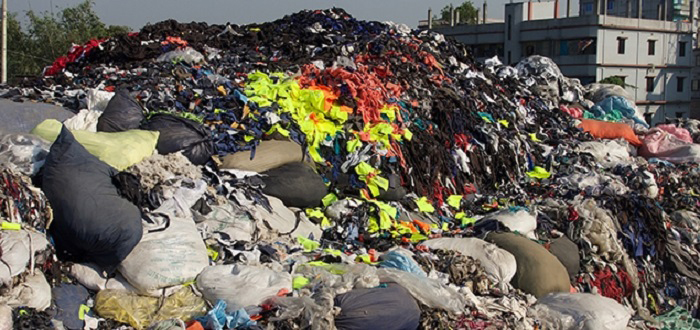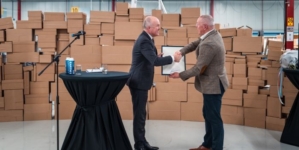-
Nutrivend selects Forterro’s Orderwise to support online expansion and streamline operations - April 11, 2025
-
ARROWXL LAUNCHES AMBITIOUS ZERO WASTE ROADMAP - April 8, 2025
-
THE BCMPA’S NEW CAMPAIGN DRIVES OUTSOURCING SUCCESS IN Q1 - April 7, 2025
-
BLACKOUT TECHNOLOGIES TARGETS TELEMATICS-INTEGRATED MOBILE DEVICE BLOCKING TO COMBAT SMARTPHONE DISTRACTION - April 1, 2025
-
Sparck Technologies awarded Royal designation - March 27, 2025
-
OpenADR Alliance announces first OpenADR 3.0 certified products with EVoke Systems, E.ON Energy and Universal Devices - March 25, 2025
-
Growing fulfilment and contract packer appoints new Managing Director - March 25, 2025
-
When is it time to invest in a WMS? Understanding the key trigger points - March 25, 2025
-
eCapital helps Vantage Recruitment on its journey to financial success - March 24, 2025
-
Hugo Beck Celebrates 70 Years of Packaging Innovation with Open House Events - March 20, 2025
Digitizing Leftover Garment Data Could Unlock Billions for Fashion Industry.
Companies operating in the apparel industry could be missing out on new opportunities for growth by not digitizing data on leftovers from garment factories, says a new report by H&M Foundation Global Change Award winner Reverse Resources.
Creating a Digitally Enhanced Circular Economy shows that manufacturers producing textiles and clothes for many of the world’s major fashion brands are spilling an average 25 percent of resources during fabric and garment production. In some cases, the volume was as high as 47 percent, much higher than usually perceived by brands. The issue, however, is not derived from a lack of brand responsibility nor waste at the factory level, but rather the result of a systemic conflict of business interests and lack of data and transparency between stakeholders at various levels of the global supply chain. According to Reverse Resources, digitization and the application of circular design principles could bridge this gap and unlock a major business opportunity for both brands and factories.
The linear pricing schemes currently in use by brands are unintentionally providing an incentive for factories not to share comprehensive and accurate data about leftover textiles and garments. These pricing schemes ‘build in’ an extra margin for factories to sell leftovers into local aftermarkets. What remains unsold is incinerated or dumped, which has both environmental and economic implications.
However, improvements in supply chain transparency and traceability could unlock a huge opportunity for growth within the industry. In its report, Reverse Resources explores how three key interventions can help brands and manufacturers create a win-win business case scenario:
Adapting the pricing scheme to give factories an economic incentive to share their leftover information;
Introducing business cases to increase the value of leftovers for factories, such as remanufacturing;
Using that information to build systems of transparency and traceability that rely on clear business case for suppliers.
“Better data from factories would facilitate virtual traceability of resources and enable digital interactions across the supply chains. These are crucial for meeting the goals of a circular economy by decoupling economic growth from environmental impacts by resource effectiveness. Material circulation of production leftovers is already established, but it is by default inefficient, corrupt, costly for end-users and out of the control of the stakeholders in the core supply chains,” said Ann Runnel, Founder of Reverse Resources.
Remanufacturing —the business case for which was the focus of a recent white paper by Earthshine and Norsk Ombruk — provides an opportunity to rebalance the pricing system by developing a viable model for leftovers, which is linked with the prices of virgin fabrics, instead of the current market prices for leftovers. According to Reverse Resources’ report, adopting such a business model could help increase the market value earned from leftovers three to four times, while simultaneously lower the FOB price of partially remanufactured garments. The approach would also reduce the use of new fabrics by three percent via the integration of leftover fabrics. The model was validated by a pilot at factories in Bangladesh. Trials are ongoing to test the scalability of the concept on a mass scale.
Research indicates that in Bangladesh alone, leftovers available from the country’s garment factories could generate an additional $4 billion if reuse, remanufacturing and recycling were applied over time. Remanufacturing could be applied to approximately 25 percent of large leftover materials, potentially growing factory earnings by three to five times.
“The figures presented are of a similar magnitude to WRAP estimates,” said Keith James, Delivery Manager of Sustainable Clothing Action Plan at WRAP. “This report is an important insight into an underexplored area. We hope that it will prove valuable in tackling this issue.”
“RR certainly lays the critical stepping stone toward sustainable manufacturing and Internet of Things, which are two of the main keywords of the Digitalization: the 4th Industrial Revolution. It is thrilling to watch how RR will help tackle the intractable inefficiency problem of the fashion industry by enabling transparent communication to optimize the material flow globally,” said Dr. Curie Park, lead researcher at the Center for Industrial Sustainability at the University of Cambridge.
Creating a Digitally Enhanced Circular Economy is a culmination of 18 months’ research by Reverse Resources, which used a €150,000 Global Change Award grant from the H&M Foundation to examine the feasibility for a software-based solution to address the pre-consumer leftover problem.
Reverse Resources is currently developing a software for garment factories and their buyers to enable remanufacturing and create visibility of resources available from production. In parallel, its goal is to build a fabric database from factories, which is a key building block for virtual through their different lifecycles. The company is currently running a pilot project with four major suppliers in Dhaka, getting backup support by H&M.
First published at: www.sustainablebrands.com
































